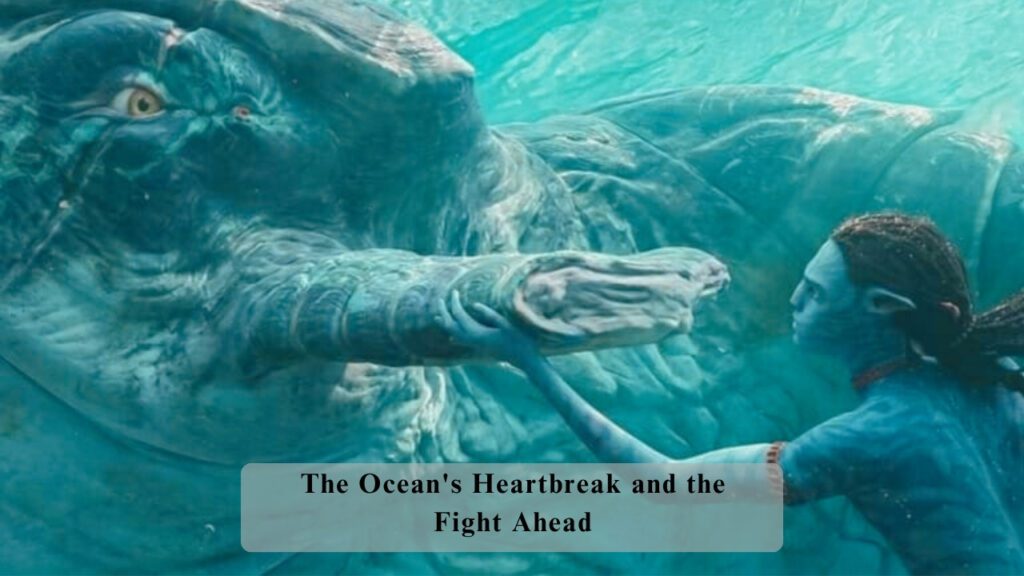Sibling Bonds and Rivalries: Kiri, Lo’ak, Neteyam, and Tuk’s Journey
Tulkun Massacre Avatar Sequel opens with a note of beauty, hope, and empathy—and then rips your heart out. As a 25-year-old movie buff, I wasn’t prepared for how hard this film hit. Over 3,000 words, I’m diving deep into:
-
Why the Tulkun matter
-
How the massacre shapes everything
-
All four siblings—Kiri, Lo’ak, Neteyam, and Tuk—and how they change
-
The Sully family’s emotional trajectory
-
Themes, symbolism, and why it matters to us
Let’s unpack the emotional layers and lasting impact of this pivotal sequel moment.
1. The World of the Tulkun: Ocean’s Soul
Before the tragedy, the film spends meaningful time introducing the Tulkun and their world. This isn’t fan service—it sets the stage for an emotional gut punch. They’re massive, gentle, nearly whale-like creatures that live in deep spiritual bonds with the ocean-dwelling Metkayina clan.
Physicality and Presence
I was struck immediately by how real the Tulkun feel—their massive bodies, phosphorescent patterns, and haunting vocalizations echo through Pandora’s seas.
Emotional Intelligence
They’re not just animals—they have family structures, songs, and empathy. During their dances and rituals, you see a culture. The film takes time to let you connect—and that connection is essential when the massacre comes.
Payakan’s Bond with Lo’ak
Lo’ak, the teenage Sully, rebels against expectations, and in Payakan he finds a kindred spirit. When they play and communicate, it’s not CGI—it’s storytelling magic. The bond builds so smoothly I forgot I was watching a fantasy film.
By showcasing this depth, the Tulkun Massacre Avatar Sequel makes the slaughter feel like a personal assault, not just a plot beat.
2. The Tragedy: Anatomy of the Tulkun Massacre
All that empathy sets the stage for tragedy. The massacre doesn’t feel sudden—it feels inevitable, slow burn. And that is the brilliance of its execution.
Scene Setting
As whalers spread out, the music dims. We’re underwater, in the quiet calm of twilight. Then a harpoon launches—impact, blood, chaos. It’s Masterclass emotional directing.
The Emotional Wave
You can feel the scream. Not the Tulkun’s, but the ocean’s, the planet’s, and your own. Cameron frames it like an elegy—each frame is poetry meant to break you.
Human Reflection
This massacre mirrors real-world horrors—whaling, habitat destruction, colonial plunder. The Tulkun Massacre Avatar Sequel refuses to allow escapism. It forces reflection: are we any different from the invaders?
Tulkun Massacre Avatar Sequel doesn’t just entertain—it indicts.
3. The Sully Family: From Refuge to Resistance
You may call this an action–adventure, but it’s also a family drama at its core. The Sully clan—Jake, Neytiri, their kids—react like real people. This is what separates it from typical blockbusters.
Jake Sully: A Father Torn
Jake’s no longer just a warrior; he’s a father overtaken by fear and sorrow. The massacre leaves him riddled with guilt. He thought running from home and war meant protecting his family. He didn’t anticipate heartbreak like this.
Neytiri: Mother of Tears
Her scream has already become legendary. Neytiri’s grief is raw and unfiltered; you don’t just see a warrior— you see a mother whose world is ripping apart.
4. Brother and Brother: Lo’ak vs. Neteyam
Neteyam’s Burden
The elder Sully son bears pressure to be perfect—warrior, protector, leader. He tries to keep the peace in the new clan, but lives under the weight of expectations.
Lo’ak’s Rebellion
Lo’ak feels lost between cultures. He doesn’t want glory, he wants purpose. In Payakan, he discovers meaning—an emotional journey that opens his eyes to a higher purpose.
Their rivalry isn’t hateful—it’s realistic. Lo’ak wants freedom; Neteyam wants stability. Both want their father’s respect.
5. Kiri and Tuk: Youth, Growth, and Resilience
Kiri: The Mystic
Kiri’s intuition is our spiritual lens. She senses danger in nature, links to Eywa, and becomes the family’s hidden strength. She’s the wild heart of the Sully clan, and by Tulkun Massacre Avatar Sequel’s end, you understand why.
Tuk: The Young Dreamer
Tuk is the emotional glue, the bright spark. She laughs, cries, terrified of war yet too young to fully grasp it. Her reactions—yelling, holding her siblings, trembling—ground the chaos. She reminds us why we fight: for children, for hope.
6. The Massacre’s Aftershock: How Everyone Changes
Payakan’s Resolve
This isn’t just personal for Lo’ak; it’s tribal. Payakan vows vengeance. He becomes a symbol of resistance—a living monument.
Jake’s Transformation
Jake is pulled back into battle, but this time with personal stakes. The battlefields of Avatar 1 were about ideology; here, it’s about vengeance, grief, and justice. Jake’s transformation mirrors ours: from watcher to warrior.
Neytiri’s Warrior Cry
She had been the protector. Now she is the fury. Her grief becomes a spiritual battlecry.
7. Cinematography and Sound: Storytelling Tools

James Cameron uses technology as a storytelling partner:
Underwater Cinematography
The ocean dances with light and shadow—reflective, eerie. The massacre is not loud chaos—it’s quiet horror.
Sound Design
Tulkun wails, water echoes, whaler engines hum hauntingly. The mix draws you in and breaks you.
Color and Contrast
Bright coral a split second before darkness. Every moment before the massacre glows with life—then everything desaturates.
8. Themes and Real-World Parallels
Ecocide and Colonialism
The film invites you to see the Tulkun as whales—similar symbolism to human history. We built empires on bones.
Indigenous Rights
Metkayina’s relationship with the Tulkun echoes Indigenous stewardship and respect. When they’re hurt, so is Pandora.
Family, Love, and Loss
This is a story about family under duress—showing us that love doesn’t make you weak. It gives you purpose to fight.
9. Building Toward Future Films
The Tulkun Massacre Avatar Sequel sets up a saga:
-
A Sully-led resistance with human & Na’vi allies.
-
Expanded spiritual powers from Kiri.
-
Lo’ak’s bond with Payakan leading a charge.
-
Neytiri/ Jake leading an underwater war front.
-
Neteyam’s death catalyzing action.
Future films will likely revive all this spiritual and emotional energy underwater.
10. Why It Hit Me Hard
As a 25-year-old writing late at night about the deepest parent-and-child love I’ve experienced—fictional or real—this film hit differently.
Nostalgia Meets Growth
I felt the nostalgia of Avatar’s world, but this time there’s more weight to loss and consequence.
Tears in a Blockbuster
Hollywood blockbusters aren’t supposed to make you cry. This one did.
A Call to Action
As technology dazzled me, the symbolism stayed. It left me questioning my relationship with Earth, with family, with conflict.
11. Deep Dive into the Siblings’ Emotional Arcs
Neteyam: Duty vs. Sorrow
As the responsible elder, Neteyam carries hope, pride, and fear. His death is the emotional earthquake—but his journey shows the cost of love in times of war.
Lo’ak: Acceptance and Identity
Lo’ak’s struggle is universal. Teen rebellion, wanting to belong, finding purpose. In embracing the Tulkun, he finds himself. He emerges from the Tulkun Massacre Avatar Sequel as a spiritual warrior.
Kiri: The Unseen Anchor
Sometimes the gentlest voices are the strongest. Kiri influences her family quietly, emotionally. By the climax, her power is understated but essential.
Tuk: Innocence Amid Turmoil
Tuk embodies innocence that holds hope. Her tears are a mirror to mine. As she grows, she carries hope for a Pandora not defined by war.
12. Screen Moments That Still Sting
he Tulkun Funeral
Scenes of M-etkayina singing, silhouetted Tulkun spraying water—shattered by stumbling bodies.
The Sibling Embrace
Post-massacre, the Sully children cling to each other. No words, just sobs. It’s raw.
Neytiri’s Rage
She howls underwater. Camera pulls away. You don’t just hear a scream—you feel Pandora collapse.
Final Thoughts: The Aftermath and the Message
This scene stays with you. For me, it unblocked something: tears I didn’t expect. It broke me emotionally, made me think, and reminded me what stories can do.
Tulkun Massacre Avatar Sequel is not just a sequel—it’s an emotional landmark. A film that proves blockbusters can be deeply human, soul-shaking, morally questioning.
Continue your movie journey with our latest blogs—start here.




